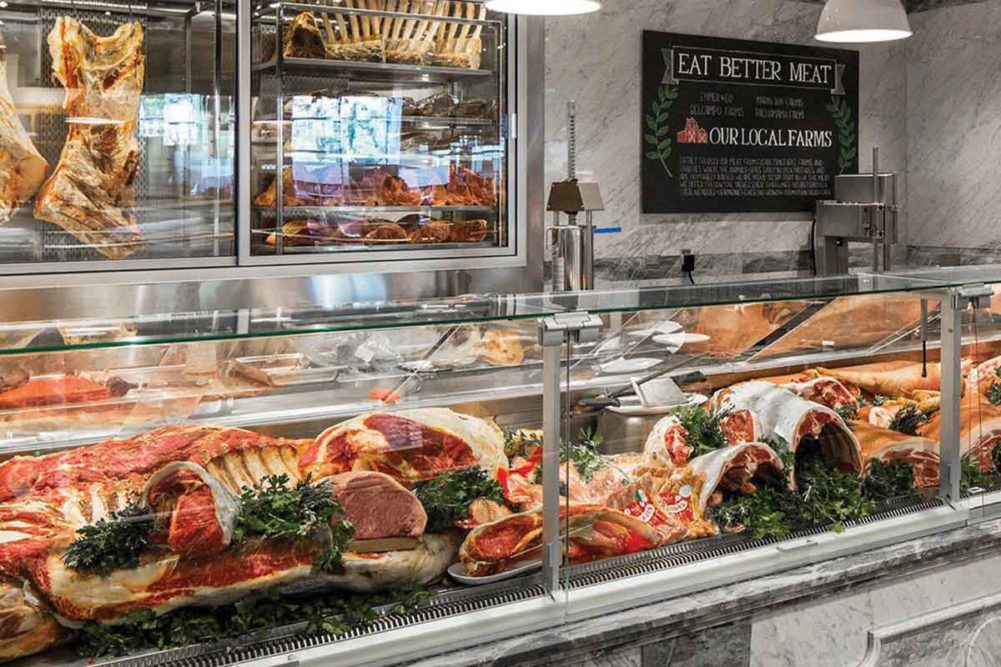Retailers are finding new ways to build excitement in the meat department. From in-store smokers to house-made sausages to dry-aging coolers, supermarkets remain bullish on driving meat sales, according to a panel of retailers at the National Grocers Association annual conference held Feb. 23-26 in San Diego. Product appearance drives sales. This includes packaging graphics, merchandising, and most importantly, the color of the meat.
Product appearance is one of the biggest challenges in most meat departments, said Courtney Brown, vice president and chief operating officer for Doc’s Food Stores Inc., Bixby, Okla. Products that are cut in-store are sometimes easier to manage in terms of loss, because the butcher will add seasoning or marinade to them and sell them as a value-added product before their appearance suffers. That isn’t an option with case-ready products.
For better eye appeal, some meat departments are merchandising fresh cuts of grass-fed meats on fake turf. Others are getting creative with in-store packaging.
“Labels matter. We are using many and varied colors and different shapes,” said Mark Salerno, meat merchandising supervisor for Wakefern Food Corp., Springfield, NJ. “This appeals to younger shoppers, many of whom are overwhelmed by our large meat department.”
Case ready color management
Retailers rely on suppliers of case-ready products to take the necessary steps to ensure desirable appearance throughout shelf life. In addition to preserving color, they are seeking solutions to the presence of excessive juices in packages.

“Color is a strong influencing factor when it comes to meat purchasing decisions,” said Catherine Bayard, global product manager natural preservation for Cincinnati-based Givaudan. “Consumers look to color to determine freshness and wholesomeness. But it isn’t a foolproof indicator and is often the source of unnecessary food waste as consumers pass up products they deem undesirable based on these visual cues. Food waste matters even more when it comes to meat because these products are often associated with a higher carbon footprint.
“Red meat products are somewhat like sliced apples with browning occurring quite quickly when exposed to oxygen,” Bayard said. “Most consumers associate color loss or browning with product degradation and assume the meat is not suitable for consumption. However, these color changes are usually due to the oxidation state of the iron ion trapped in the heme of the myoglobin.”
The oxidation cycle begins with exposure to oxygen and leads to the formation of metmyoglobin, which is responsible for the brown color. To limit browning and maintain the red color longer, the catalyzers – the oxygen – must be quenched to inhibit the oxidation mechanism. And while myoglobin is the protein responsible for color change in meat, pro-oxidants, such as temperature, metals and light, may exacerbate the situation. Antioxidants introduced upfront retard the oxidation process.
Once the meat is changed, there’s no going back. While color change alone does not impact eating quality, it is suggestive of other undesirable sensory changes.
“All meat is susceptible to color change due to oxidation. From the moment the meat leaves the processing facility, oxidation begins,” said Courtney Schwartz, marketing director for Kemin Food Technologies, Des Moines, Iowa. “During this reaction, volatile compounds begin to form. They begin to react with the meat, causing the process to start all over again. Eventually, this causes color change in the meat as well as off-flavors and off-odors.
“To put it simply, consumers expect fresh beef to be bright red, cured meat to be light pink and ground poultry to be light or dark pink,” Schwartz said. “Any variation from these colors deters the consumer from buying the product. Therefore, it is imperative for manufacturers to prevent color loss in their meat and poultry products in order to keep consumers coming back for more.”
Poulson Joseph, director of protein innovation for Kalsec, Kalamazoo Mich., added, “For the cooked meats category, cured meat products are challenged with color fading, since the cure color pigment (nitrosyl hemochrome) is very sensitive to retail light exposure. Sliced products such as deli meats and sliced dry sausages, especially pepperoni containing carotenoid pigments from paprika, are the most vulnerable products in this category for discoloration.”
The incorporation of high-performance natural plant-based preservation solutions help processors improve meat appearance. They also help to eliminate food waste and increase processors’ and retailers’ bottom line.
“The ultimate value is increasing revenue from longer shelf life, avoiding the loss of revenue from recalls and maintaining brand and corporate reputation,” said Mark Cornthwaite, industry and marketing manager for DuPont Nutrition & Biosciences, New Century, Kan.
DuPont has an extensive range of antioxidant solutions for managing color. These are based on rosemary and green tea extracts, as well as acerola powder.
“With strong natural and clean label attributes, these products have been proven to maintain color and flavor and provide an additional two to four days shelf life,” Cornthwaite said. “Applications include a wide range of processed, marinated and fresh meat.”
Kalsec offers natural plant extracts that serve as antioxidants for extending color shelf life in meat and poultry products. “Our ‘building blocks’ include rosemary extract, which is our flagship product, as well as new tools such as acerola extract and green tea,” Joseph said. “We have multiple combinations of these, either catering to different color stability or various labeling needs.
“Regarding the mode of action, we often describe rosemary extract as a ‘free-radical scavenger,’ which delays oxidative reactions/damage and indirectly helps maintain color stability in meat products,” Joseph said. “Acerola extract plays a direct role in helping to convert and reduce the metmyoglobin (brown color) to red-colored oxymyoglobin form, and thereby extend the bloom (cherry-red color) in fresh meats.”
With processed meats, where naturally derived colors are permitted, Kalsec offers blends of rosemary extract with permissible colors, such as paprika, as well as spice-herb blends. These all-in-one systems assist with color and deliver on flavor.
Frozen meats are not exempt from color changes. Antioxidants are helpful in the freezer, too.
“Slow freezing may not secure or stabilize color in meat,” said Tom Rourke, business development director of meat for Corbion. “Further, when meats become freezer burned from being frozen too long in the presence of oxygen trapped in the packaging, they may turn gray and dry.
“Rosemary is a natural antioxidant widely used to aid in color stabilization for ground beef, pork and poultry,” Rourke said. “It can be labeled simply as rosemary or natural flavor. Another natural antioxidant we use is acerola, a variety of cherry that can provide color stabilization in ground meats and other muscle meat products. In addition to its antioxidant properties, it is also high in natural ascorbic acid and is a natural curing accelerator. It is typically labeled as cherry powder.”
Naturex, a part of Givaudan, has developed several clean-label single ingredient and blend solutions to address color preservation. These ingredients result in products with greater sensory appeal as well as clean-label claims, according to Bayard.
Kemin offers natural plant extracts such as rosemary, green tea and acerola extracts and blends of these ingredients to help extend the shelf life of color in meat and poultry. These products also act as antioxidants to delay the onset of lipid oxidation that occurs in meat and poultry.
St. Francis, Wis.-based Wixon Inc. markets a line of natural antioxidants that help with maintaining color and flavor in fresh, frozen, pre-cooked and further processed meats. Available in liquid and dry formats, the ingredient system is declared simply as natural flavor. It has also been shown to stabilize the breading system in deep-fried applications by reducing the rancidity associated with frying oil while enhancing overall flavor.
“This natural flavor reduces the rate of oxidation, aids in bloom retention and fosters a fresh-like appearance when applied to fresh beef and pork,” said Ron Ratz, senior vice president.
Managing pH may also assist with fresh meat and poultry appearance. The package matters, too.
“The pH can impact color, purge and even texture,” said Tom Katen, senior technical services specialist for Cargill Salt, Minneapolis. “Both salt and potassium chloride provide chloride ions that are negatively charged. By raising the pH slightly to the alkaline side, salt and potassium chloride increase the product’s water-holding capacity. This can help control and retain fresh meat moisture, preventing it from coming out of the product and into the package as purge.
“This moisture includes the water-soluble sacroplasmic proteins, which contain the myoglobin pigment responsible for meat color,” Katen said. “Loss of this pigment through purge results in fresh meat items with the faded, dull or washed out look that consumers perceive as older and undesirable.”
Schwartz added, “Packaging that is see-through will likely lose color faster due to the meat’s interaction with light. Opaque packaging delays that color loss, but may not be seen as ‘fresh’ to consumers because they can’t see the product. Other technologies such as nitrogen flush, high-pressure processing and modified-atmosphere packaging help to change the environment in which the meat is in, in the tray, to help slow down color loss.”
Plant-based opportunities

When it comes to plant-based meat analogs, color is also important. The science behind color delivery and changes over shelf life is different than with animal protein and often will vary with product formulation. The main challenge in coloring plant-based meat analogs is to maintain the desired shade of color from package to plate without looking too fake. Because plant-based products are often targeting health- and wellness-conscious consumers, highly stable artificial colors are not an option.
The logical option is plant-based colors rich in the natural reddish pigment anthocyanin. The greatest challenge is that anthocyanins are not very stable and can go from red to bluish with a slight increase in pH. Identifying a stable color is paramount.
“Consumers choosing plant-based meats tend to be flexitarians and therefore are looking for their products to be representative of the real thing,” said AnnMarie Kraszewski, application scientist for Chr. Hansen, Milwaukee. “Using natural colors requires a balance of two to three shades to provide the ‘raw’ as well as the ‘cooked’ appearance. Several factors, including pH and water activity, may affect the stability of a natural color and therefore the ‘fresh’ appeal.”
The company has a new range of clean-label red colors based on its proprietary sweet potato, which took more than 10 years of selective breeding using traditional, non-GMO methods to develop. The result is a plant-based, brilliant red that is a natural alternative to carmine and synthetic colors. Usage levels vary by the meat being simulated. A ground beef analog would require more than a poultry-type nugget.
“Sweet potato provides a stable red that keeps the fresh appearance in plant-based products,” Kraszewski said.
Sensient Colors, St. Louis, markets a beefy color based on beet juice. It delivers an intense, bright, dark red shade in neutral pH environments and also stands up to heat processing.
“Food scientists are tasked with creating a faux burger that looks, tastes and smells just like the real thing,” said Zack Henderson, technical service manager at Sensient. “One way to help plant-based meats imitate the appearance of actual ground beef and maintain a simple, vegan ingredient list is color from botanical sources. Your approach will be different depending on aesthetic goals and pH environment.”
Beet red helps provide the pre-cook red of a beef patty and can assist with red juices after cooking. If the ground analog is intended to be a cooking product, red is desirable up front, but then some brown is necessary for cooked beef appearance.



